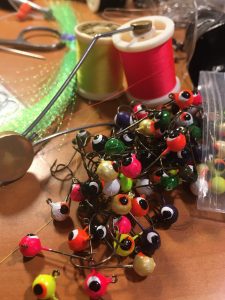 Our Outdoors: Long Night Luremaking
Our Outdoors: Long Night Luremaking
By Nick Simonson
January in the upper Midwest is the sportsman’s most challenging month. Major hunting seasons have ended, the flash of fins from early ice begins to slow down as the winter doldrums set in, and typically the temperatures are the lowest of the year and the conditions are the most challenging. Add in a foot or two of snow and mobility on the landscape or the lake can even become a deterrent to getting out there and enjoying winter hunting and fishing opportunities. While the days may seem to drag on in the depths of winter, and spring and summer seem far off over the horizon, now is the time to prepare for upcoming angling adventures and create those flies, lures and jigs that will get the job done when the water starts to flow once again. In the process, a connection is made between the winter nights where new patterns are dreamed up with those warm summer evenings where those finned fantasies become reality.
The long dark nights of mid-winter often find me at my office desk, turning monofilament around the red hooks of crawler harnesses for walleyes or whip finishing the thread wraps on a dressed treble which will form the business end of an in-line spinner for pike and muskies. The piles of colored marabou and krystal flash that mount on the marker-stained and glue-dotted wood surface of the workspace make it look as if I have taken a trimmer to the hair of a circus clown as I plow through a couple dozen crappie jigs. Between crafting some favorite standard tackle options and filling the gaps in my fly box with the nymphs, streamers and dries that were offered up to trout and panfish last season (along with a few trees and shrubs on the back cast), my desk goes from clean to cluttered in just a matter of days and requires a monthly reset whenever it seems the two pair of scissors I keep end up disappearing beneath the mountains of material or it becomes impossible to find a bottle of sealant buried under a stack of colored bucktails.
While it’s sometimes a lesson in organization that cuts into tying time, it’s the welcome freeform feel of an eighth grade art class that more often melts the winter nights away and speeds along the red digital numbers on the clock radio on the top shelf of the book case. In those instances where I can jump from material to material and project to project with each new session and sometimes even from pattern to pattern in a single night, the feathers and fur really fly and the desk becomes even more disheveled. With a few standard offerings piled up, I consider substitutions: marabou instead of bucktail, pheasant in place of partridge, synthetic hair snuck in over the real thing from any number of animals. Some creations come out cockeyed and appear to be something only a mother would love and a carp would eat, but it can be surprising in spring when suddenly the experimental jig pattern becomes the successful staple spurring a sudden summer session at the desk to tie up another dozen. In those moments – especially after a bite-off of the last of my Frankenstein creations – I often lament that I didn’t tie up three or four more in those winter spurts of creativity, despite not knowing how well that particular prototype would do. That’s part of the learning experience and the list of hand-written notes of colors, materials, sizes and successful lures that gets checked off as January blurs into February is a sign of good things to come.
These nights may be long and the challenging conditions may make indoor days more likely, but there are plenty of projects to undertake in preparation for spring, particularly in the process of making those patterns that will catch fish and ones that may be the next big thing in my tackle box. Time at the vise is never wasted and filling up a desk two or three times with strands of sparkle, trimmings of tail feathers and bits of bucktail along with a full selection of go-to patterns produces both immediate and long term satisfaction…in our outdoors.
